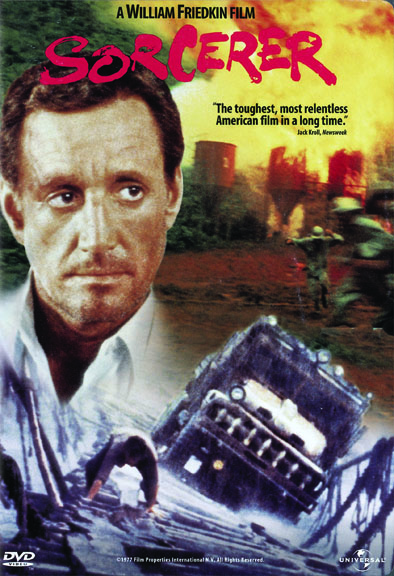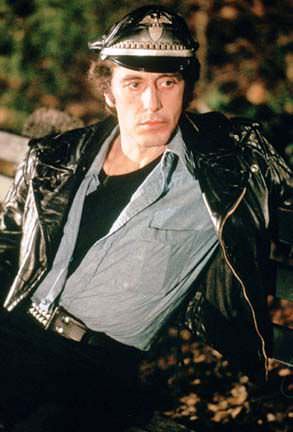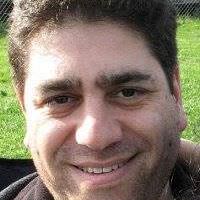Talking With Legendary Director William Friedkin
William Friedkin, legendary director of The French Connection (1971), which won him the Best Director Oscar, and The Exorcist (1973), one of the greatest horror films of all time, recently published his memoirs, The Friedkin Connection, a candid look at his early life and his long movie career.
We caught up with him as he was touring the country to promote his book, as well has host several screenings of his late 70’s masterpiece, Sorcerer (1977), which this summer underwent a digital restoration supervised by Friedkin. It's premiering at the Venice Film Festival this week, as well as getting a theatrical re-release from Warner Brothers and Universal. New Blu-Ray and DVD editions will follow later in the fall. Mr. Friedkin will also be receiving the Golden Lion for Lifetime Achievement at the film festival.
The Credits: I would like to talk a bit about Sorcerer (1977), because I know you have been working on a digital restoration of the film. What inspired you to want to do a new version of Henri-Georges Clouzot’s The Wages of Fear (1953)?
Friedkin: I had seen The Wages of Fear back in Chicago before I ever became a film director. I loved the film, as well as Clouzot’s other masterpiece, Diabolique (1955). I came back to it about two or three years after I finished working on The Exorcist (1973). It then just occurred to me that The Wages of Fear was kind of a timeless theme. It was about four strangers who didn’t like each other. They were all imprisoned by their own sins, and they had to either cooperate with one another in order to survive, or blow up. It seemed to me that that was a metaphor for the world at that time, and even more so now.
So I went to see H. G. Clouzot [the director], and I spoke to him and told him what I had in mind. He said, “ok, but I don’t own the rights. They are owned by George Arnaud [author of the French novel on which the film was based], and he and I haven’t spoken in years.” I asked if he would mind if I contacted Arnaud, and he said, “no, you’re doing an American version of this, it will be different enough.” I said it would be the same thing, but with different characters and different situations, and I would want to dedicate the film to him. And he said that was not necessary, but I did it anyway. At that time I could neither read nor speak French, so I hadn’t read Arnaud’s novel. My knowledge of it, and what [screenwriter] Wally Green and I worked from, was the film.
Watching the film again recently, I noticed that there is very little dialog in the film.
Well, that was a conscious thing on my part. When I went on tour for The Exorcist, in Thailand, where they ran a few American films and other foreign films, there was never a version either dubbed or subtitled in Thai. So they used to run an American film, often on a sheet tacked to a wall, and a guy would stand next to the screen and they would stop the projector every ten or fifteen minutes, and this guy would explain to the audience what the characters had said and what was going on. I made a silent vow to myself to never again make a film where they would have to stop it to explain it in Thai.
Sorcerer seems to be made up of about ten to fifteen very tight action sequences with little to no dialogue. Was that created during the screenwriting process or did it evolve in the editing?
Yes, events. It’s a series of events that coalesce at one point maybe 40 or so minutes into the film. And yes, Wally Green, who wrote the script, contributed enormously to it. So many of the ideas were his, and all of the writing was his. I only altered a few things when we got to the actual locations. It’s his screenplay and I don’t share the screenplay credit with him because I don’t deserve any screenplay credit.
When you were working on location on these extensive action sequences, did you do any preparatory storyboarding?
No, I never storyboard anything. What you have to do is get them in your mind’s eye. You have to see them, feel them. And that’s how you make those sequences, one shot at a time. But you have to see, visualize, the whole sequence.

For instance, the scene with the trucks crossing the frayed rope bridge. You shot that for several weeks, if not months.
Yes, but not every day. We had a usual pattern. Two rivers virtually dried up on us. The first river was in the Dominican Republic. It was twelve feet of rushing water, but by the time we had built the bridge and got ready to shoot, it was down to less than a foot. But John Fox, the production designer, found another location with a similar river in Mexico. That was also about twelve feet of rushing water, and it dried up to about three feet. So I had to add a lot of different effects, mechanically, not digitally, because we didn’t have CGI or anything like it. So I added rain, we brought in these big pumps and pumped water out of the river, we dammed up the river so we were able to have a bigger flow than was actually there, and I needed cloudy days to shoot it because of the rain. But it was sunny all day when we were there, so we could only film in the morning. Then we would have to stop and shoot something else, but in Mexico there was nothing left to shoot, so we just had a hiatus until about 6 in the evening, when we could come back and shoot a split day, from about 7pm, when the sun had gone down, until about 10pm, when we ran out of light.
During that time, were you continually building up the shots and the sequences while you were shooting them?
Yes, because we never saw rushes. We had to send the negative back to California to be processed. There were very few phones and it was very difficult to get a call through, but the director of photography, John Stephens, was able to get a call through to the lab maybe once a week to determine that the stuff was ok. But we didn’t see it. I didn’t see it until I finished shooting. I had no idea what we were getting, or whether it was properly shot or exposed. There was a great deal of trust involved. When I came back to Los Angeles to edit the film, I was pleasantly surprised. The stuff looked pretty damn good. The editor, Bud Smith, and I put it together without any necessary order. We sort of improvised the montage, although it’s certainly based on an event that begins at point A and ends at point Z.
Some of your films seem to have a structure of independent montage sequences, that don’t necessarily have to be placed in a strict narrative order.
Yes. When you get in the editing room, the film that you shot almost speaks to you, almost literally. That happened to me with The French Connection (1971), where I had taken out nine scenes that I had shot, and I was convinced they had to be in the final cut. As I was putting them in and trimming them and sequencing them, it was almost as though a voice was screaming at me, “no, no, I am not this. I am that. Get this out of there.”
In the sequence after the four main characters are chosen for the mission, there’s a tracking shot of Roy Scheider looking at the broken trucks, which leads into an extended montage of them fixing the trucks, and which includes cuts of an abstract flame [from the oil well explosion] and also two close ups of Francisco Rabal’s face, as he is waiting to kill one of the guys. You’re telling the story, but a viewer gets an almost visceral pleasure from the editing and the soundtrack music by Tangerine Dream.
It’s telling the story visually. When I shot those different scenes, I had no idea how I was going to use them. I had made close-ups of the big oil well fire that I didn’t know how I could ever use again. I had a beautiful close-up of Rabal, and I shot it because he was sitting next to a candle in his room, and the light was so beautiful on his face that I made shots of him without knowing how I could use them. The whole sequence of rebuilding the trucks, in effect raising them from the dead – that’s one of the reasons why the second truck is called Lazaro, or Lazarus – I thought I would keep that whole scene together without any interruption when I shot it.
Are you trying to subvert whatever genre your working in through the formal qualities of how you shoot it and how you edit it?
Yes, I think that’s true, but I don’t set out to subvert anything. I just love to discover the process, and I feel that the process of editing is like a dialog between myself, and the film that I’ve shot. I remember reading about F. Scott Fitzgerald, some 50 or 60 years ago, that he had a little card pinned to a bulletin board above his wall where he typed his novels. The card said, “action is character.” I’ve tried to follow that. What a person does is who they are. You don’t have to explain them, you just show what they’re doing and that’s who they are.
I’m so glad that the movie is going to get out there again and people are going to see it.
I’m glad that the film is coming out. I think it’s really a tribute to the people that made it. That may sound like bullshit, but I don’t bullshit. I’m not out to confuse anybody or blow my own horn, but that film and all of my films are collaborations of many people. I was the director, but there were other people whose contributions were equal to mine, I assure you. People like John Fox, our art director, and Roy Walker. Roy became a really great production designer.

Can we talk a little about Cruising (1980)? I recently watched the film, and in doing a little research I came across a 2004 essay by film critic Bill Krohn. From reading the essay and seeing the film, it seems you were really trying to have several people portray the killer.
That came out of the editing process. It wasn’t in the script. I didn’t realize that that was a possibility until I got into the cutting room. I thought, the actual murders that [Paul] Batson confessed to were basically unsolved. There were still a lot of questions, because there were a lot more body parts placed in huge drawers in the morgue marked “CUPPI,” which stood for “circumstances unknown pending a police investigation.” There were many more CUPPI murders than the ones that Batson confessed to, and it was not all gay men. It occurred to me, that as these murders were not solved, there may have been other possible explanations.
In his essay, Krohn refers to you as a montage director. He says you work with “modules” of scenes that you moved around during the editing process.
That’s correct. The whole meaning of the film was a question. How were these murders committed? A fantasy-like atmosphere existed in New York at that time. Not only these murders but other mysterious deaths were occurring, primarily but not exclusively in the gay community. Shortly after that, these deaths had a name: AIDS. When I was filming Cruising, maybe scientists understood the cause and effect, but we didn’t know about AIDS until about a year later. So there was a kind of a panic around New York. It was best captured by this really sensational writer for the Village Voice, Arthur Bell. He wrote about the deaths in the gay community and the murders, as kind of warning shots to gay men. I read those articles and they were part of what inspired me to make that film.
It seems that most reviewers at the time were writing about the protests and controversy around the movie, rather than reviewing the movie itself.
As I recall, most of the people who reviewed the film, reviewed their feelings about gay rights, gay liberation and the gay lifestyle. The reviews were largely attacks on me for making such a politically incorrect film. There were no politically correct films about gay life in those days, because studios for the most part wouldn’t touch them. If they did, everything was watered down and nervous about dealing with the subject. It was a completely different era. Today there are gay people in the mainstream of all stories. There has been tremendous progress in gay life since then. But at the time, there were a number of critics who thought that Cruising would increase the attacks on gay people, both physically and in print. It would increase murder and violence against the gay community. Fortunately that didn’t happen.
Your last movie, Killer Joe (2011) was the first movie you shot digitally. In terms of the new technology, where do you think the industry is headed?
Well, here’s what I’m aware of. I can’t say that I endorse this, but this is the way things are going. They are going toward streaming. All of the studios are counting on a gigantic revenue stream from streaming films to people on their iPhones, iPads, computers and television sets. That is the next big thing in terms of the economics of filmmaking. In other words, they’re trying to get rid of all of the hardware and software. 35 millimeter [film] is dead and gone. Eastman Kodak is out of business, and so is Fuji. Most of the theaters, and all of the major chains, have converted to digital projection. So that’s where the technology is going. I don’t know how much it will affect the films themselves in terms of stories and characters. You still have to light a scene interestingly or even beautifully. I don’t know that the stories are going to change much. Most of the films today are only enhanced by the digital technology. Most of the films today are about comic books or video games or vampires, or werewolves. They are complete fantasy. One of the most important anniversaries in the history of film is May 1. On May 1, 1941, Citizen Kane opened at the RKO Palace in New York, and it changed film forever. They aren’t making too many Citizen Kanes today. Citizen Kane couldn’t rely on digital technology, but the effects produced mechanically and optically are just wonderful, and all in service of the story and the characters. Citizen Kane would not be a better film if it was done in 3D or digitally. It is by far the greatest film I’ve ever seen. I love a lot of films, but that is the one that inspired me, and so many others, to try to become a filmmaker.
Thank you for speaking with us, and congratulations on being awarded the Golden Lion at Venice, and on the restoration of Sorcerer.
Thank you and thank you for your time, I appreciate it.
Featured Image: Cruising (1980). William Fridkin and Al Pacino on location in NYC The title will be available in the very near future from Warner Archive Collection. Courtesy Warner Brothers.



